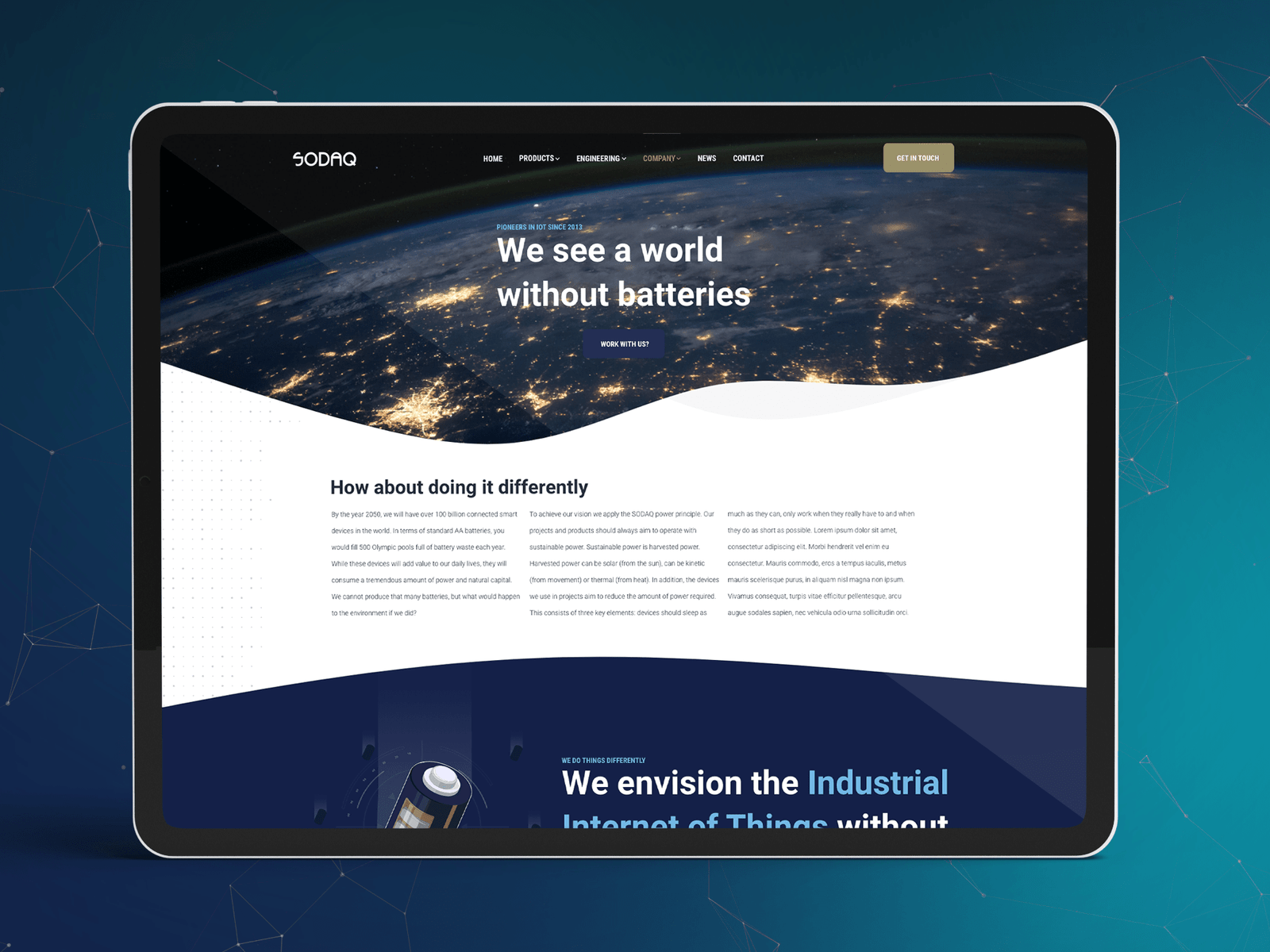As a brand, you can’t escape hiring a good copywriter. Regardless of what you sell or present, you do so with the written word. This is exactly where copywriting comes in.
Words matter. A message even more so. Sometimes three words are enough to give a brand meaning. Words create an identity. Long articles with detailed product descriptions don’t matter. Reading a book is done in your spare time, not while shopping.
Just as you have no desire to read through the terms and conditions of your new toothbrush, your customers have no desire to study a tome about your services. It should be short and sweet.

Sebastian Smeenk
Business developer
As with graphic design and with the overall customer experience, the attention span of consumers is very short. Your texts must be catchy. They should summarize the gist and make it immediately clear what your brand stands for.
But copywriting is much more than that. It’s a psychological process where you influence customers to do something. Just as a commercial salesman used to pull out all the tricks to sell you that Internet subscription, a copywriter does so with clever words.
Why is copywriting essential for your brand and website? How can the use of words be the deciding factor for your customers? You’ll read about it in this blog.
What is copywriting?
The Americans have a wonderful definition for copywriting. John E. Kennedy, one of the first and best-known copywriters of his time, called it “Salesmanship in print.” In Dutch, it would loosely translate to selling something on paper. How do you sell something on paper? With written words and good vocabulary.
These days, the idea of copywriting is often confused with other terms. With the growing technology industry today, many professions are changing names. It is also called the Englishification of the Dutch language. In copywriting, this is the same.
Content Writing vs. Copywriting in digital marketing: what are the differences?
Some 20 years ago, people also wrote from behind their computers. These were then often web editors or simply copywriters. After the rise of social media, the “Content Writer” came to life. Content is often confused with copy. However, there is a clear difference.
A content writer often writes longer, informative articles. Their main purpose is to inform and entertain the reader. It’s a bit like journalism in that regard. A copywriter does something different.
The goal of a copywriter is for texts to prompt the reader to do something. Often the goal is commercially motivated. A copywriter writes texts in such a way that the text responds to the reader’s feelings, desires, and problems. Landing pages, product descriptions, email marketing, advertisements: all written by a copywriter.
So copywriting is an important part of UX and UI design. Almost all websites use words, instructions and explanations. This should all be right down to the fingers and especially not too long. Good copy should respond directly to customers’ feelings. So a good copywriter, like a UX designer, will need to fully empathize with the visitor or customer.
Forms of copywriting
Website copywriting
The landing page and main page of a website are written by a copywriter. Each word should be well considered and should make it immediately clear what something is referring to. A marketer must have good copywriting skills. From research from the Missouri University of Science and Technology shows that visitors scan the text of a Web page within five seconds before navigating to the next section. So you have five seconds to grab the reader’s attention. Make it count!
SEO copywriting
Without ranking in Google, your website doesn’t really count. To satisfy the algorithm of the main search engine, texts should be written according to SEO. Search Engine Optimization makes sure you use the right keywords in your text. Without SEO skills, writing is basically useless. Your site will only start to count if enough SEO keywords are met.
Product copywriting
The purpose of any copywriting is to promote or sell something. With product copywriting, it’s the same, only here you specifically address the characteristics of your product. In doing so, you put yourself in the customer’s shoes. What does he or she want to know, and how do you make sure you present the product in the most positive way possible? If you sell vegan protein shakes, for example, then you know what to anticipate. The taste is not the most important thing, but the effect on muscle growth with a plant-based diet. Take advantage of this.
What is UX copywriting?
As mentioned above, professional names and tech savvy terms continue to evolve constantly. One of the newest terms is UX copywriting. The big companies in particular – Google, Amazon, Microsoft, Booking.com – want real UX copywriters these days.
The difference from “normal” copywriting is minimal, but does matter. Copywriting is a broader term. It beats email marketing, blog posts, slogans, white papers and so on. Copywriting refers to any form of commercial writing. It is writing the commercial text. No more, and no less.
Meanwhile, no one can have failed to notice what the process of UX design stands for. The goal is to give users, consumers and customers an optimal experience and encourage them to make a purchase. This is the same with copywriting, only there we use words. When we combine UX and copywriting, we complete the process.
Microcopy
The difference is in microcopy. A UX copywriter uses minimal words – on digital buttons, error messages, notifications, loading screens – to prompt a user to do something. A few examples of microcopy by a UX copywriter are:
- Not satisfied, money back!
- Already 5000 customers have gone before you
- Order now!
Dead simple, right? Maybe so, but zat companies often go wrong. Using the right words in the shortest possible way requires experience and thought. It’s a process you have to map out. Say only that which is necessary.
UX copywriting is more than just persuasion. An important part is also to remove possible doubt from consumers. This can only be done by choosing your words carefully. The above example of “Not satisfied, money back” is one such example.
At all times, you want to prevent consumers from hesitating and therefore not ordering a product. You can remove this doubt by reassuring people. Giving money back is one example, but it can also be done by adding testimonials from satisfied users.
Loss aversion
There is another craftier trick that UX copywriters employ. It is called loss aversion. This involves clearly highlighting the negative consequences of a particular action. By calling a blog, for example, “The five reasons your shop will fail.” This immediately attracts attention, but also scares people. As a web shop owner, you think: I need to read this, because I need to know if I am making these mistakes too.
What you can also do is link the negative consequences to not buying a product in another way. If you sell a course on dating to thirty-somethings, you might mention that “67% of singles over 36 no longer find a partner.” Incredibly manipulative, but this is how copywriting works.
Copywriting research
To sell effectively, you will need to do good research on your target audience. This is part of UX and UI design, as we know. In copywriting, you can appeal to specific data. An SEO tool can give you insight into search engines. Well-known SEO tools are Ahrefs, Moz SEO and Semrush. These types of tools are becoming increasingly important to marketers. What kind of questions do people ask Google, and what kind of answers do they get? This is something you, as a copywriter, can capitalize on.
In addition, it is important to know what a consumer wants. What is the consumer’s problem, what is he or she looking for, and how can you as a company offer a solution? Once you have established this for yourself, you can have a copywriter respond to this in a useful way.
As mentioned, there is always a desire behind the purchase of a specific product. It is often an underlying motivation of a consumer. If you know how to incorporate this well into your text, you will be a successful copywriter.
How do I handle this?
Good question! That you need to think carefully about copywriting as a business owner is now clear. Hiring a good UX copywriter is the smartest thing you can do. Too often entrepreneurs go wrong by writing their own copy.
Don’t misunderstand, there is nothing wrong with this. As an entrepreneur, you are passionate and want to describe your product as comprehensively as possible. This is only right. Still, it’s wise to show your written work to a UX copywriter.
First, it is always good to have someone else look at your written work. The written work of the most seasoned journalists doesn’t just get placed in newspapers, either. Three more different people often look at this. So why wouldn’t you have this done as well?
An experienced UX copywriter knows exactly what works and what doesn’t. Based on a series of questions, together we find out who your customers are, what problem or desire they have, and how best to respond. In any case, it is wise to have a Quick Scan to be done by dusver. That way we can immediately see how your brand is doing, and whether we need to improve your texts. Good for your brand and for your customers.







